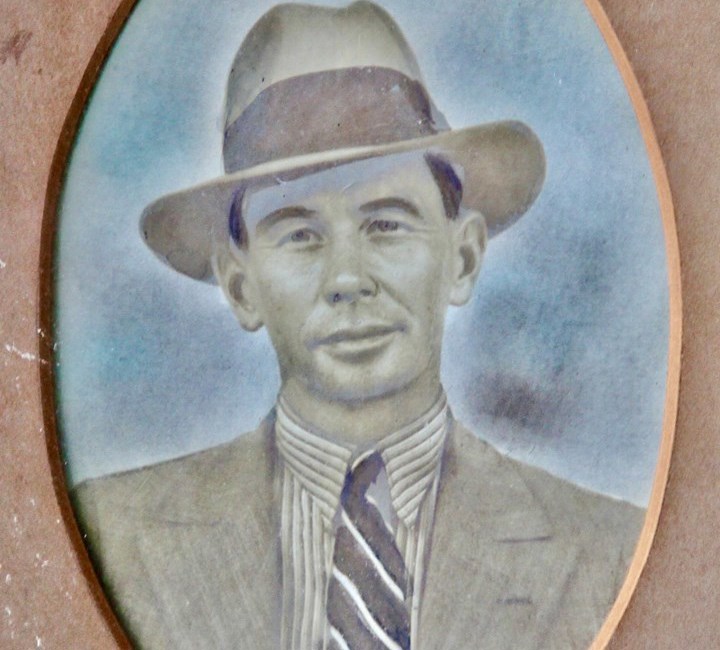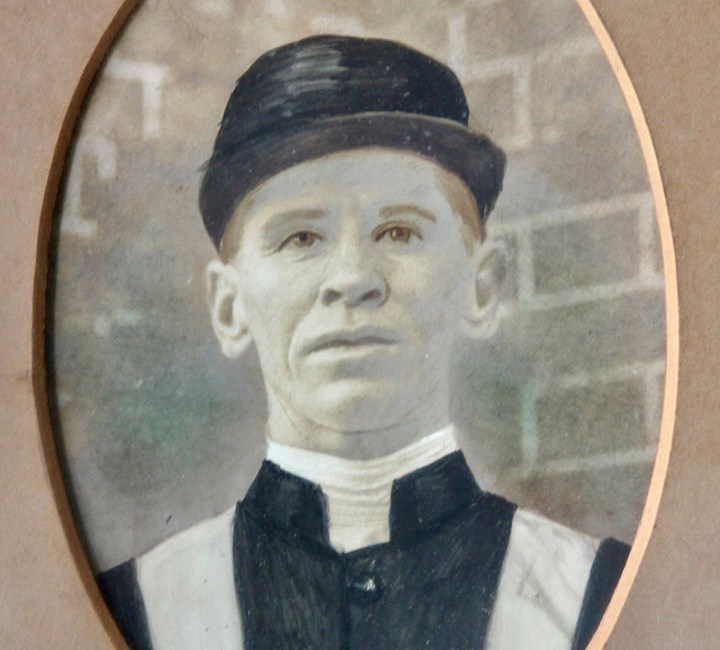
Central Queensland racing's Anzac connection
Cover photo: Ted Tanwan (front centre) and his brother Bill (front right) (Courtesy Tanwan Family Collection)
By Ross Stanley
This period of the year is prime time for recalling the deeds of the nation’s First World War armed forces.
There is a remarkable story about the brothers Edwin (Ted) and Bill Tanwan. The pair hailed from Banana, a spot that is a half an hour west of Biloela and not far from Thangool.
It was not named after the tropical fruit, but rather after a very useful yellowish bull with that moniker that cleverly assisted in directing troublesome cattle into yards in the 1860s.
Before enlisting in January 1916, the Tanwans experienced an ideal grounding in droving, horse-breaking and, like their father Walter Edwin (Teddy) Tanwan, amateur riding in the local area.
Coincidentally, another pair of brothers from Banana in the shape of Jim and Fred Shean were cousins of the Tanwan lads through their respective mothers, the Cue sisters Kate and Ellen.
After cutting their teeth in Central Queensland, Ted, Bill, Jim and Fred went on to be associated with elite-level success stories.
One freakish angle concerned the result of the 1931-32 Brisbane Jockeys Premiership.
Fred Shean topped the table with 50.5 wins while Ted Tanwan was the runner-up with 46.5.
WARTIME
The Tanwans were sent to France with the A.I.F. 42nd Battalion in 1916. The 5th Light Horse Regiment, C Company was Ted’s initial assignment while both Queenslanders also served with the 54th Battalion.
Ted, born on December 22, 1894, was wounded on the Western Front in June 1917. Sinews in his right arm were severed while the left limb suffered several serious punctures. During his treatment a week later at London’s Bethnal Green hospital, he thought he would never be in a saddle again. His weight soared by a stone and a half (around 10 kilograms ) and his muscle tone deteriorated. On the positive side was his visit to the stables of King George V.
Come September 27, the rising 23 year-old was heading home for more months of medical work. Thankfully, he recovered.
Bill, who first saw light of day on February 19. 1897, was not as fortunate. He was shot twice in July 1917. After rejoining the frontline the following month, he was shot again in the Ypres-Passchendaele zone in the October and was missing in “no man’s land.” He survived that near impossible ordeal but his war service file noted that the condition of his chest, left leg and arm, with its shattered elbow, was rated as dangerous.
Following a lengthy stint in an Aldershot hospital in Hampshire, the younger Tanwan sailed for Australia in January 1918 and was discharged from the Army four months later. Alas, his left arm was permanently bent. Mercifully, he was able to profitably switch to training.

POST WAR
In the 1920s, the Tanwans made a living primarily in the Wide Bay region, where Ted was apparently the leading hoop six times, and the Rockhampton district.
The foundation money spinners included Skopus Boy and Marcus Highfield. Sir Sarchedon won seven straight with three in a row in Rockhampton and four in Brisbane. It was short odds about taking it to eight in the QTC Flying on Boxing Day in 1929.
Although he hurt a knee in running, he hung on to be second to I.O.U.The Paper Money gelding, in receipt of ten pounds, was to be the next Stradbroke Handicap hero.
The unregistered course at Kedron Park with its lower grade contests was the Tanwans’ launching pad in Brisbane in the pre-1931 period.
Bill Tanwan had a sharp eye for horses he could buy or lease. His artful conditioning skills reaped rewards as he often unlocked the problems of his charges.
His star acquisition was Rivalli, a 600 guineas purchase that banked £6,000.The gelding by the 1923 Melbourne Cup runner up Rivoli was unbowed three times at Eagle Farm in open company, with Ted atop, over seven days, commencing on Boxing Day 1934.
The side’s raid on Sydney in 1935 claimed the AJC James Barnes Plate and the City Handicap. Not long after, the team took out the 1935 Brisbane Cup by a head with 9.3.
The Daily Standard (4 June 1935) reported that “Tanwan’s jockey brother, Ted, quickly hit the front and settled down Rivalli to the necessary pace that enabled him to reserve his best effort for that desperate run to the judge that scored by only as much as Tanwan lost the Doomben Cup a fortnight ago.
LOUGH NEAGH
Incidentally although Tanwan was obliged to endure an all round roasting over his tactics on Lough Neagh at Doomben he contends that if he had been allowed to ride that chestnut according to his own plans he would have won that cup also.
After the Doomben Cup loss and 13 victories for Ted, Fred Shean became Lough Neagh’s chief partner.
Twenty seven of the idol’s 32 wins were handled by the cousins from Banana.Ted’s haul included the 1931 Queensland Guineas-Derby double and three Sydney features while Fred’s tally embraced nine key Sydney events and home hits in the 1936 Brisbane Cup, 1934 BATC Newmarket and two QTC King’s Plates.
In 1938, Fred Shean nabbed a magnificent springtime treble with King’s Head (AJC Epsom), Buzalong (Caulfield Cup) and Catalogue (Melbourne Cup).

CLASSY CONVEYANCES
The wonderful mare Lady Linden was a case of mixed luck for Ted. They secured the 1931 Tattersall’s Cup and QTC Ascot Handicap (6f) but he was kicked at the barrier prior to the start of the sprint’s 1937 version, leaving the substitute hoop Barty Sinclair to take home the bacon. A month’s suspension in 1932 cancelled Ted’s booking for the popular mare in the VRC Newmarket. She annexed it at 33/1.
Ted Tanwan’s name is also on the honour board for the QTC Derby (1933, Waikare; 1935, Auto Buz), QTC Guineas (1935, Auto Buz; 1936, Brownfelt), Queensland Cup (1935, Soft Step), QTC Metropolitan (1930, Mintman,; 1931, Poy Patrol; 1936,Thalwyn; 1937, Brownfelt), the 1931 QTC Champagne Stakes and the 1932 QTC Sires Produce Stakes with Brown Paddy and the 1933 Claret Stakes courtesy of Utterer.
With Regular Bachelor, he chalked up the 1935 QTC Ascot Handicap and, despite the 10.0 handicap, was on top in a Flying at Eagle Farm. After the side picked up a Rosehill Flying in February 1936, the superb work continued in the 1936 VATC Futurity Stakes and the 1936 VRC Newmarket. At Flemington, the brown entire lost several lengths when he met the tan crossing on settling down. Tanwan kept cool, letting his steed find his balance. It looked like mission impossible but his powerful turn of foot prevailed.
While in Melbourne, Ted pursued a favourite, fitness inducing pastime. A newspaper photograph showed him playing tennis at Caulfield with his sons Des and Ron, a future trainer.
Incidentally, Fred Shean booted home Regular Bachelor in the 1937 All Aged Stakes on the same date that he collected the AJC Cumberland Stakes with Lough Neagh.
Around three years later, Fred’s brother Jim had two highly promising “colts”in his yard.They were his apprentices Neville Sellwood and George Moore. The latter scored for Ted Tanwan when he took up training in 1940 after his weight had reduced his opportunities Along the way, he had served in positions such as the vice-presidency of the Distressed Jockeys Fund.
It was apt, given his youthful European exploits, that a neddy named Volunteer was an early winner that Ted prepared.
Down the track, his lodger Bombardier and Bill Tanwan’s Hall Chief shed their maiden tag on the same Albion Park card on September 8, 1945.
A major thrill was the 1946 QTC Ascot Handicap win by Everton. There was an amazing thread with Patrick Newman’s Gum Poster, a multiple winner that took out Lismore’s 1951 Pescud Handicap. Newman, like Ted, had survived fighting for the 42nd Battalion.

WHAT WERE THE ODDS?
So what would bookmakers have put up about the life expectations for combatants when they arrived on the Great War’s ghastly front-line more than a century ago?
The Tanwans not only weathered the bloodshed but progressed to be highly accomplished in the equine business. One of the other monumental challenges they had to confront was the Great Depression of the 1930s.
Bill was 90 when leukaemia claimed him, but he went out a winner. His lottery ticket birthday gift was a $1,000 windfall, and he died soon after. Ted reached the age of 94.












